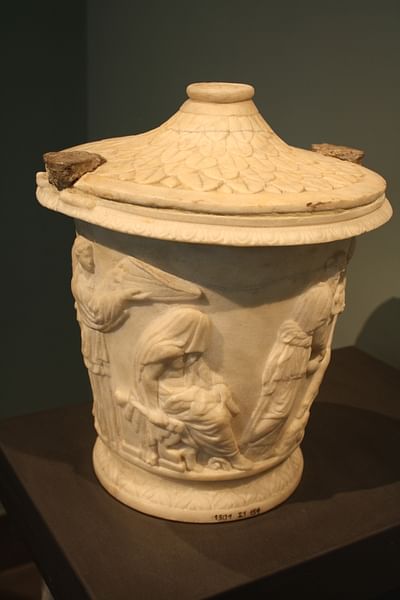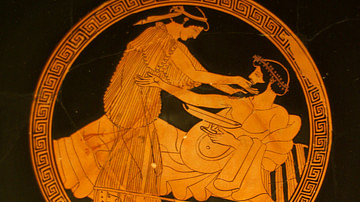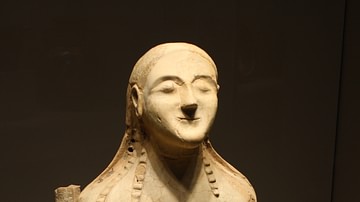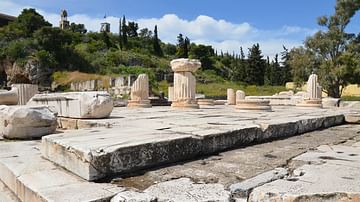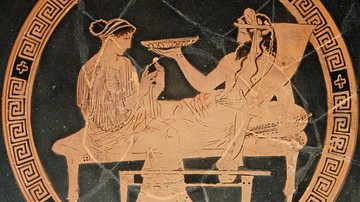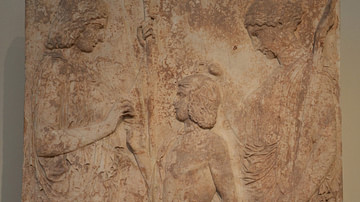The Rites of Eleusis, or the Eleusinian Mysteries, were the secret rituals of the mystery school of Eleusis and were observed regularly from c. 1600 BCE - 392 CE. Exactly what this mystic ritual was no one knows; but why the ancient Greeks participated in it can be understood by the testimonials of the initiated.
The Eleusinian Mysteries, held each year at Eleusis, Greece, fourteen miles northwest of Athens, were so important to the Greeks that, until the arrival of the Romans, The Sacred Way (the road from Athens to Eleusis) was the only road, not a goat path, in all of central Greece. The mysteries celebrated the story of Demeter and Persephone but, as the initiated were sworn to secrecy on pain of death as to the details of the ritual, we do not know what form these rituals took. We do know, though, that those who participated in the mysteries were forever changed for the better and that they no longer feared death.
The rituals were based on a symbolic reading of the story of Demeter and Persephone and provided initiates with a vision of the afterlife so powerful that it changed the way they saw the world and their place in it. Participants were freed from a fear of death through the recognition that they were immortal souls temporarily in mortal bodies. In the same way that Persephone went down to the land of the dead and returned to that of the living each year, so would every human being die only to live again on another plane of existence or in another body.
Demeter & Persephone
The story of Demeter and Persephone is the most significant myth of ancient Greece precisely because of its influence on this understanding. While the tales of Homer and Hesiod informed the culture, and those concerning Heracles were significant expressions of cultural values, the Demeter story offered something which other myths could not: a vision of eternal life and triumph over death.
Demeter, the goddess of nature, had a daughter, Kore (which means `maiden'), who was kidnapped and, by some accounts, raped, by Hades, lord of the underworld. Demeter searched for her Kore all across the earth in vain, finally coming to rest by a well in the city of Eleusis. There, disguised as an old woman, she cared for the queen's son, baptizing him nightly in fire so that he would be immortal. When the queen, one night, found her nursemaid placing her son in the fire she was understandably upset - but not as angry as the grieving goddess who then threw off her disguise and revealed her glory and her wrath.
Mollified, as long as the people would build her a temple in Eleusis, Demeter taught the queen's son, Triptolemos, the art of agriculture. Zeus, king of the gods, persuaded Hades to return Kore to her mother as, in Demeter's grief, the crops were dying, people starving, the gods not receiving their accustomed tribute. Hades agreed but had tricked Kore into eating some pomegranate seeds and, if one ate in the land of the dead, one remained with the dead.
As she had only eaten some, however, it was agreed she would spend half the year with Hades in the underworld and half with her mother on earth. Kore emerged from the underworld as Persephone (`she who brings doom') the Queen of the Dead and, while she remained on earth, Demeter caused the world to be fruitful while, when Persephone was in the underworld, the plants withered and died; thus the seasons were explained. More importantly, however, the myth reflected the concept of transformation and the cyclical nature of life. One's existence did not end with death because there was no death; there was only change from one state of being to another.
The Mysteries
The rituals were enacted twice a year. There were the Lesser Mysteries, which took place in the spring, and the Greater Mysteries which those who had been purified earlier took part in when September came. They walked the Sacred Way from Athens to Eleusis calling for the Kore and re-enacting Demeter's search for her lost daughter.
At Eleusis they would rest by the well Demeter had sat down by, would fast, and would then drink a barley and mint beverage called Kykeon. It has been suggested that this drink was infused by the psychotropic fungus ergot and this, then, heightened the experience and helped transform the initiate. After drinking the Kykeon the participants entered the Telesterion, an underground `theatre', where the secret ritual took place. Most likely it was a symbolic re-enactment of the `death' and rebirth of Persephone which the initates watched and, perhaps, took some part in. Whatever happened in the Telesterion, those who entered in would come out the next morning radically changed. Virtually every important thinker and writer in antiquity, everyone who was `anyone', was an initiate of the Mysteries.
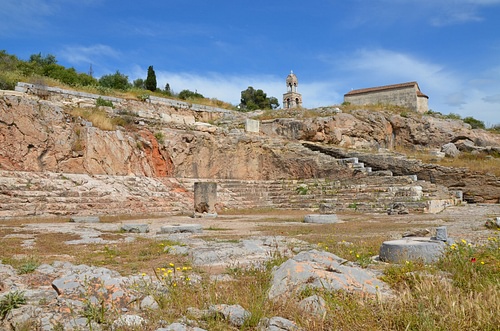
The Testimonials
Plato, an initiate himself (as Socrates was before him) mentions the Mysteries specifically in his famous dialogue on the immortality of the soul, the Phaedo: " our mysteries had a very real meaning: he that has been purified and initiated shall dwell with the gods" (69:d, F.J. Church trans). In the Myth of Er, the last chapter of Plato's Republic, a warrior named Er is killed in battle and goes to the afterlife but, unlike the others who accompany him, does not drink of the waters of the River Lethe which would cause him to forget his life on earth and move forward into the next.
Er instead comes back to life on the battlefield and tells his companions about what he saw in the next world and what death is like. He makes it clear that death is not the end of one's life but only the beginning of another part of the journey. Interestingly, Plato never introduces this story as a `myth', as a fiction, but treats it as a factual account. The translation of the chapter as the `myth' of Er has been unfortunate as it should actually be understood as the account or story of Er. The report of Er is quite probably a reflection of the vision one received from the Mysteries.
Plutarch, writing to his wife on the death of their daughter, says, "because of those sacred and faithful promises given in the mysteries...we hold it firmly for an undoubted truth that our soul is incorruptible and immortal. Let us behave ourselves accordingly"(Hamilton, 179). Further, he says, "When a man dies he is like those who are initiated into the mysteries. Our whole life is a journey by tortuous ways without outlet. At the moment of qutting it come terrors, shuddering fear, amazement. Then a light that moves to meet you, pure meadows that receive you, songs and dances and holy apparations" (Hamilton, 179). This description is quite similar to the report given by Er in his account.
Cicero writes, "Nothing is higher than these mysteries...they have not only shown us how to live joyfully but they have taught us how to die with a better hope" and the 20th century historian Will Durant states of the mysteries, "In this ecstasy of revelation...they felt the unity of God, and the oneness of God and the soul; they were lifted up out of the delusion of individuality and knew the peace of absorbtion into deity" (Durant, 189). Historian Waverly Fitzgerald sums the experience up clearly writing, "It was said of those who were initiated at Eleusis that they no longer feared death and it seems that this myth confirms the cyclical view of life central to pagan spirituality: that death is part of the cycle of life and is always followed by rebith" (2). Every ancient testimonial reflects this same understanding and each has the same tone of enlightened liberation from the fear of death.
Egyptian Influence
Just as important was a new-found meaning to one's life. Initiates recognized that their lives had an eternal purpose and they were not just living to die. A belief in the transmigration of souls - reincarnation - seems to have been central to the vision of the Mysteries and this provided people with a sense of peace in that they would have another chance, many other chances, to experience life on earth in other forms.
It is quite likely that the Mysteries were influenced by Egyptian religious beliefs which understood death as a transition to another phase of existence, not the end of one's life. The Egyptians had maintained this belief since at least the Early Dynastic Period (c. 3150-c.2613 BCE) and, since there was contact between the two cultures through trade, it is probable that this Egyptian understanding contributed to the deeper interpretation of the Demeter and Persephone story and the vision of the Mysteries.
Although Egyptian belief regularly emphasized an ideal afterlife in the Field of Reeds, a paradise which was a mirror image of one's life on earth, it also recognized the spiritual reality of reincarnation, as did most pre-Christian religious. Time was considered cyclical, not linear, and one could recognize the pattern of the universe through the changing seasons and understand that, just as trees, grass, and flowers died in one season and returned to life in another, so would human beings.
The End
The Eleusinian Mysteries differed from conventional religious practice in that initiates were experiencing first-hand what others were only hearing about in the temples. The traditional worship of the gods was founded on stories told of how the universe worked, the will of the gods, and what those gods had done. The difference between this kind of religious experience and that of the mysteries would be the same as that of acting in a play compared with hearing about a performance; the actors are going to have a much different, and more meaningful, experience. Even so, there is no indication that initiates looked down on traditional religious practices or considered themselves superior. Plato most likely did but only because he already thought he was better than his contemporaries.
The Mysteries were enacted for over a thousand years and, in that time, provided countless people with a higher understanding of life and what waited beyond death. The rituals were closed down by the Christian Emperor Theodosius in 392 CE as he saw the ancient rites as inspiring resistance to Christianity and the `truth' of Christ. As Christianity gained more adherents and power, pagan rituals were systematically stamped out although core meanings, iconography, and symbolism would be appropriated by the new faith and transformed to support the belief in Jesus Christ as the messiah.
The former sites of great pagan ritual and learning were abandoned, destroyed, or turned into churches throughout the 4th and 5th centuries CE. The temple of Demeter and every sacred site in Eleusis was sacked by the Arian Christians with Alaric, King of the Goths, in his invasion of 396 CE, leaving only ruins and rubble where once the people of the ancient world gathered to experience viscerally the truths of life, of death, and the promise of rebirth.
